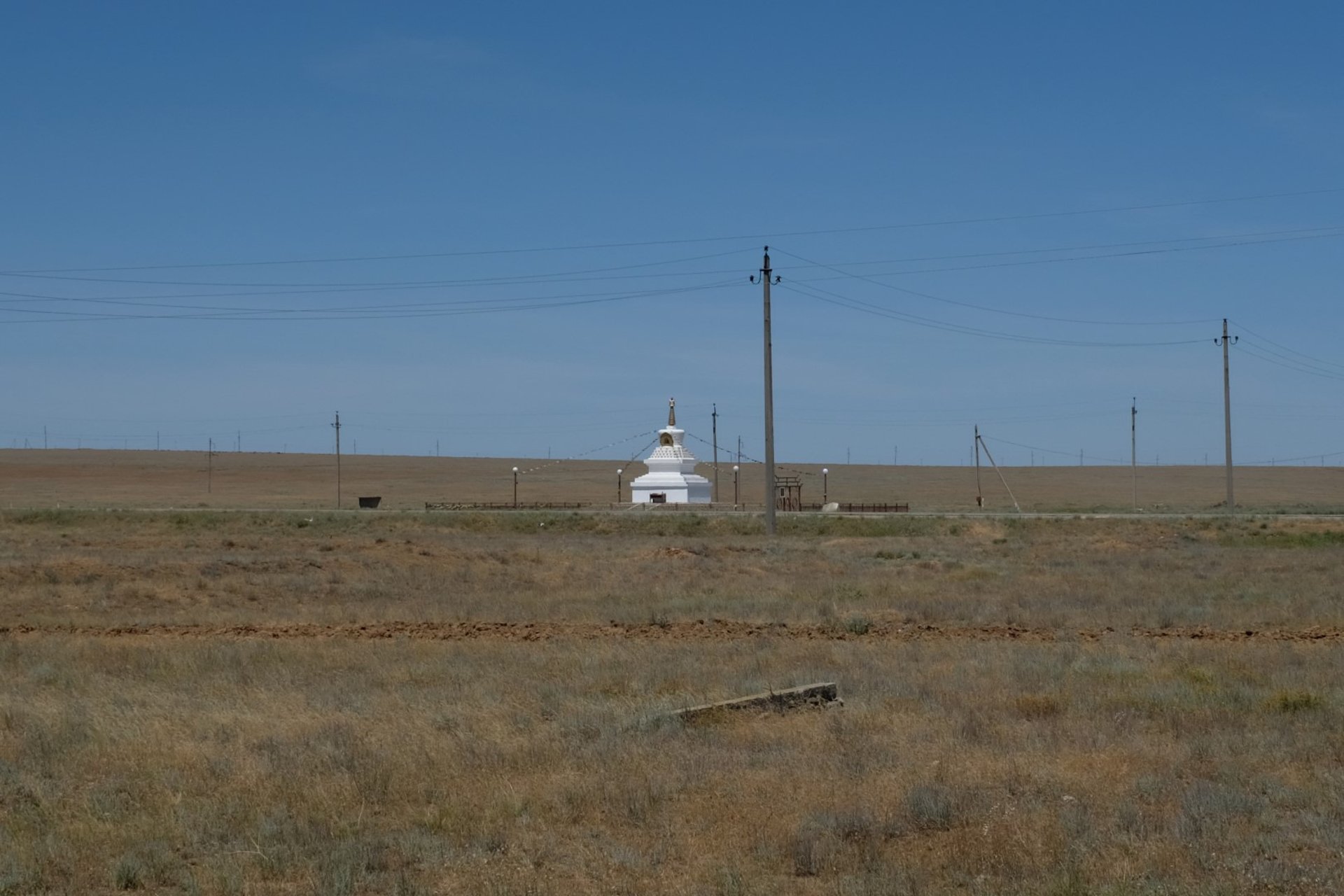
Flotsam on the Grass Sea
2018, Elista, Kalmykia
RUSSIAEUROPERELIGION
I first heard of the Kalmyks through the music of Kimmo Pohjonen; a strange, beautiful man from Finland who plays the accordion. "Plays" would be selling it a bit short though; this is what you'd call avant-garde music. I saw him perform live once. He surprised the audience by emerging from behind the stands, and then he pranced and pirouetted through the crowd on his way to the front. I had a big grin on my face and so he came and sat down beside me for a spell, throwing me a friendly nod before ascending to the stage. He was all decked out like something between a punk and a shaman. His accordion likewise was a cyborg of an instrument, custom-built and electrified, and he was equally happy squeezing harmony or dissonance out of it. My favourite album of his is Kalmuk, in which he collaborated with fifteen orchestral musicians and two rock drummers to create a storm of music and tell an epic story without words. The title gives the only explicit clue to the inspiration for the work, and in following it I was surprised to find doors opened to history and geography I had till then known nothing about.
The Kalmyks are a Mongolian people who migrated in the seventeenth century from Dzungaria, in what is now western China. Their destination was Russia's steppe grassland to the west of the Caspian sea, putting them within Europe. Traditionally they adhere to Tibetan Buddhism, and they are the only people of this faith to have established a historical homeland outside of Asia. A turbulent history was to follow their migration, with a sometimes hostile, sometimes friendly relationship developing between these newcomers and the Russians. Successive Tsars made use of the Kalmyks as allies against the different Muslim peoples living on their frontiers, but by the reign of Catherine the Great the interference from the Tsarist administration had pushed a large part of the nation into a return migration to Dzungaria. It's estimated that only a third of those who set out lived to see their destination in Qing China. The Kalmyks who remained in Russia later joined the doomed rebellion of the Cossack Yemelyan Pugachev, and saw their autonomy further eroded as a result. After the Russian revolution they were persecuted by the Bolsheviks for supporting the anti-communist White faction, and Joseph Stalin's collectivisation of agriculture sounded the death knell for their ancient nomadic lifestyle. Perhaps the single greatest trauma came during the Second World War, when the Kalmyk nation was deported en masse to Siberia and Central Asia after the authorities accused them of collaborating with the Germans. In 1943 the entire population was forced to leave without notice and in the middle of winter, and many died during the journey. The exile was ended under Stalin's successor Nikita Khrushchev, and the Kalmyks returned to become an autonomous republic within the Russian Soviet republic. In today's Russian Federation they retain a limited form of independence along the same lines.
Notes from a modern shaman
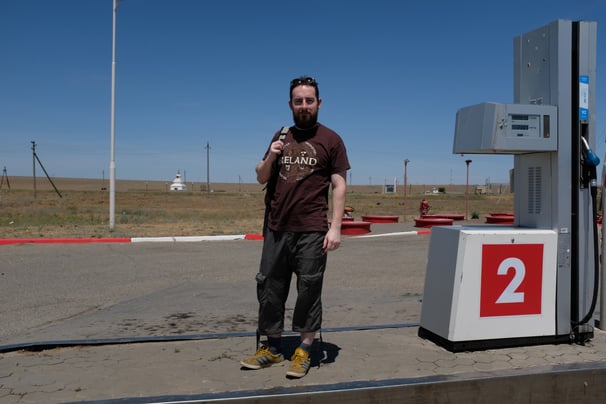

Pitstop on the road from Volgograd to Elista
In June last year I was in Volgograd, only 300 kilometres from Elista, the capital of Kalmykia. By Russian standards that's only next door, so I could hardly miss it. I'd allowed myself just enough time to make the four-hour journey there and back on the same day. There are a few ways to cover this route, with bus and marshrutka (mini-van shared taxi) connections from Volgograd, but I went with the ride share network BlaBlaCar, a popular option in Russia. This is organised hitch-hiking for a fare, and a good way to travel cheap and easy. I found a well rated driver to get me to Elista by the afternoon on his way south to Grozny, and another driver for the return journey in the evening. We set off early in the morning, and for a good half an hour I took turns with two other passengers and the driver trying to knock down the language barrier. The man behind the wheel was a tough looking Chechen with a square jaw and a shaven head, and he surprised me inside the car with his friendly banter and out of it with his short stature. It seems he was in the military. In fact he used the word spetsnaz, at which I tried not to appear too credulous, though he certainly looked the part. He made a casual attempt at persuading me to forget about Elista and go on with him to Grozny instead, which I'm sure would have been interesting, but I kept to the plan. About half-way into our journey the landscape flattened out dramatically. We had reached the true steppe, the great grass sea which separates and joins Europe and Asia. It was in this setting, so similar to the Mongolia of my imagination, that I caught sight of a little white Buddhist stupa. These are dome or cone shaped monuments built to house holy relics, and serve as places of meditation. We were on the approach to Elista then, and I saw it out in the middle distance from where we'd stopped to refuel. The last time I'd seen one was in Nepal, more than ten years before. A little while later and the driver was dropping me off at Lenin Square in the centre of town. Only once he was satisfied that I knew where I was going did he set off, leaving me with a salute.
Continent leap

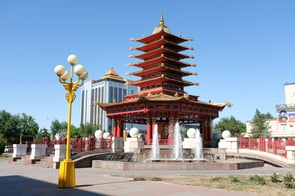
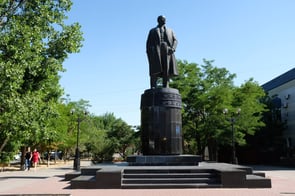
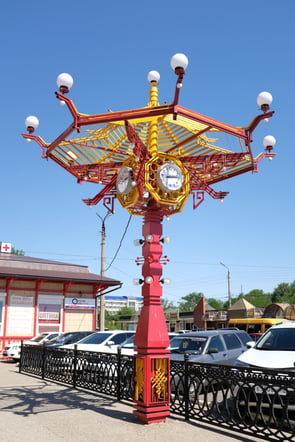




When we came by the stupa it was like I'd been teleported into Asia, and now in the centre of Elista that feeling was compounded. The signage was in Cyrillic and the odd face on the street was European, but apart from that there was little in front of me to suggest I was still in Russia. The people around me were mostly Kalmyks, with their Asian features, and likewise the architecture and even the lamp posts and railings surrounding the square and the main avenue spoke of Mongolia and Tibet. One exception was the typical Soviet statue of Lenin, for whom the square is named. It's a fine enough example but it fails to compete for attention with the red and gold Пагода Семи Дней (Pagoda of Seven Days) and the large fountain with golden lotus flowers, which together occupy the centre of the square.
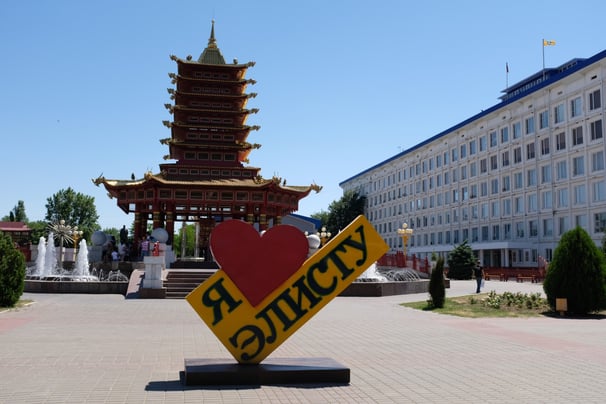

Obligatory "I love Elista" sign
Curiosities on Lenin Square
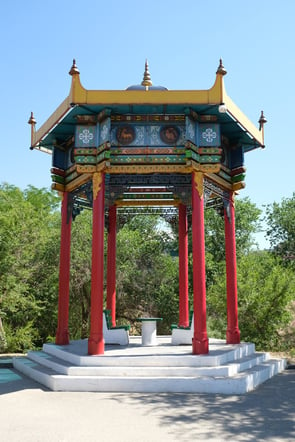

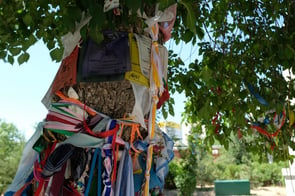
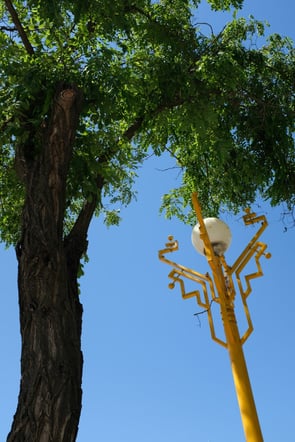




A walk in the park
I had set just one essential point on my itinerary; the Золотая обитель Будды Шакьямуни (Golden Abode of the Buddha Shak'yamuni), the largest Buddhist temple in Europe. There was plenty of time, so before making my way there I let myself wander off in the opposite direction. Southwest from the statue of Lenin the Золотая Арка (Golden Arch) caught my eye. This is a beautiful monumental gateway painted in red, blue, green and gold, once again loudly announcing Elista's Asiatic identity. It marks the entrance to a little park, called Дружба (Friendship), where you can take a stroll and visit several interesting monuments. Just before entering the park I passed a small statue of the Buddha sitting under an ornate pavilion, and once inside I came across Белый Старец (The White Old Man), a stout little statue of the figure from Mongolian folklore, a guardian spirit of life and longevity.
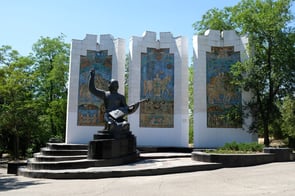
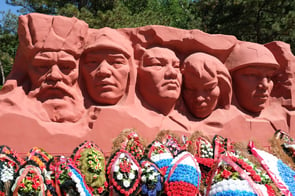


Further onwards I found a statue of a musician holding a dombra, and behind him there stood three large decorated stelae. In green and blue, yellow and brown, these illustrate events from the national poem, the Epic of Jangar. The musician is a Jangarchi, one of the traditional performers of the epic. Finally towards the end of the park I met a plaza dominated by a large sculpture in the style of America's Mount Rushmore. Five Kalmyk faces are carved out of a slab of rose-tinted stone, representing the heroic generations of the Civil and World Wars. Russia Day had been celebrated two days before my visit and so the monument was lavishly endowed with flowers.
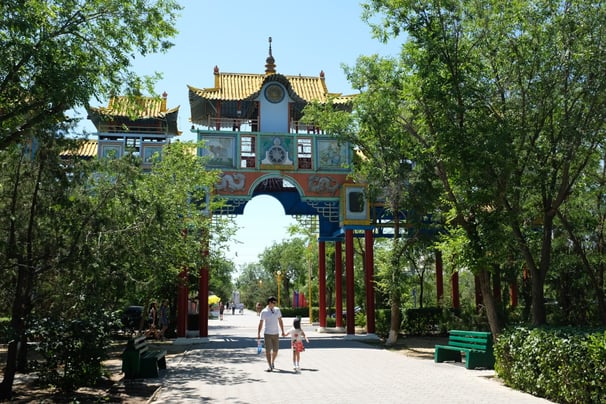

The Golden Arch
I had lunch in the park and then turned north-east onto Ulitsa Lenina, the main road through Elista, and continued straight towards the temple. The Golden Abode is not actually the oldest Buddhist temple in Elista; that title goes to the Старый Хурул Сякюсн-Сюме (Old Khurul Syakusn-Sume). Located on the south-western outskirts of the town, from what I've read it seems to be an elegant and historic building in quiet surroundings, worth travelling out to. Unfortunately when I visited Elista I wasn't even aware it existed, but wouldn't have had time in any case. Another three kilometres south from the old temple, the Ступа мира (Stupa Mira) could make another atmospheric stop. On the eastern edge of the town I would also have liked to visit the Памятник Исход и Возвращение (Monument to the Exodus and Return), a sculpture raised to commemorate the Kalmyk nation's painful uprooting under Stalin. Nearby the statue there is a small museum inside a wooden rail carriage, like those used to carry the Kalmyks into exile. The Ступа Просветления (Stupa Prosvetleniya) would make a good stop on the way back, a twenty minute walk to the west. What I missed at these spots though was well compensated for by Elista's main attraction.
When I found the Золотая обитель Будды Шакьямуни (Golden Abode of the Buddha Shak'yamuni) it appeared suddenly, towering impressively, if a little incongruously over its modest surroundings. The building itself is massive, and sits on top of a large artificial mound for extra height. Its precinct is a well-manicured garden of red roses and verdant grass, studded generously with wooden pavilions housing prayer wheels and statues of Buddhist saints. Ringing the temple itself are rows of red prayer wheels with golden inscriptions. The concept of a prayer wheel is simple, and charmingly modern. By giving one a spin you put the inscribed words into motion, automating your prayers and saving you doing it the old-fashioned way with your mouth. The perimeter features four enormous, ornate gateways marking the directions of the compass. Even the exterior fence is something to be seen, with its pillars topped by little miniature stupas and its railings coated in colourful prayer flags. Once you enter, the approach to the temple leads up a staircase split by a cascading fountain.
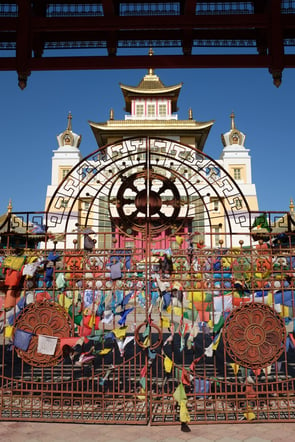
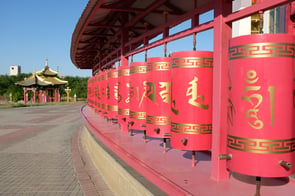
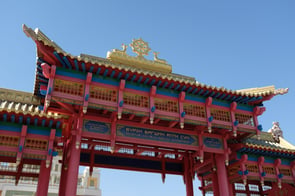





The Golden Abode
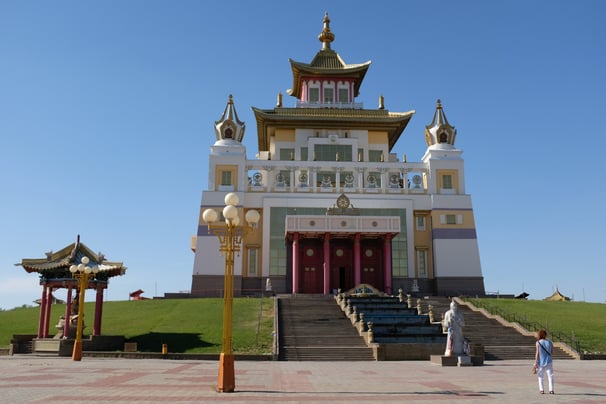

The interior is a beautiful, calm space filled with colour and presided over by a huge sitting Buddha. I paused inside for a long while. Moving along the walls, you can see paintings of the Dalai Lamas, the leaders of Tibetan Buddhism. Their faces are mostly simple, stylised representations, with the exception of the present and fourteenth Dalai Lama, who jumps out at you with his bespectacled, photogenic smile. He came to visit Kalmykia in 2004, and the Golden Abode was founded a year later in December 2005. It is hoped the Buddhist leader will return in the future to consecrate the building, though the prospects of this are unclear given Russia's alliance with China and the often suspicious attitude of the central government towards the ethnic republics. The building also houses a small museum of religious artifacts.
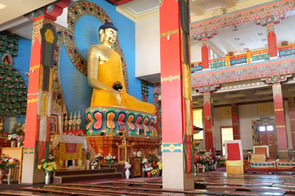
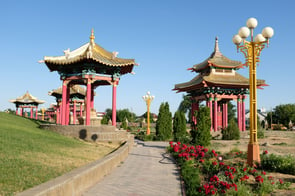


After I'd left I had a little time left to wander before meeting my lift home, so I drifted eastwards to the Ostap Bender monument. This was one final little curiosity for me in town, and something outside of the general theme of the Kalmyk nation and its Tibetan Buddhist faith. Ostap Bender is a fictional character, the lovable rogue and hero of the novels The Twelve Chairs and The Little Golden Calf by the Soviet authors Ilya Ilf and Yevgeni Petrov. I haven't read these books but it was interesting to catch this glimpse into Soviet culture; a fictional character from the Ukrainian city of Odessa, so widely popular as to get his own statue here. Backed by the eponymous twelve chairs, Bender leans jauntily on one leg, gazing wryly at the most agile of chess pieces, the knight. I moved on from there to the meeting point designated by my driver, near a local school. He wasn't responding to my messages, but I contented myself that he'd understood from my poor grammar that I was not Russian and would not be interesting to chat with. I waited patiently until he was about a half an hour late, at which point my dwindling phone battery gave me the push I needed to book a different driver. Luckily, I'd packed a portable battery charger. Sure enough the first guy never showed up, and it was dark when I met his replacement, a cheerful young Armenian who spoke a few words of English. We chatted a little as we left town, and he told me the area I had been waiting in would be dangerous after dark. At that point though I was on my way home, and I slept most of the four hours back to Volgograd. I was not awake to see the warping of the land as we came away from the steppe, or the small white stupa which had seemed to mark its shores.
Literary allusion
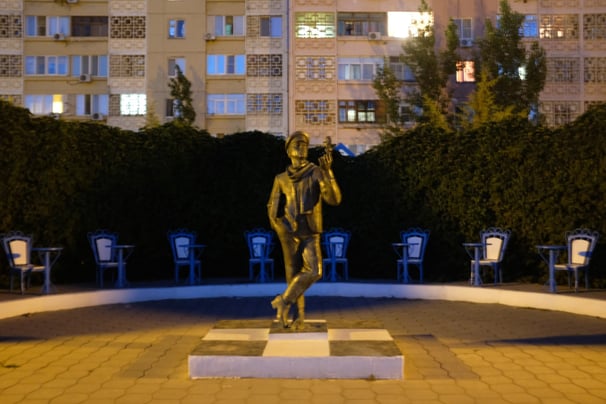

The Gist: Elista
ARRIVED: I travelled to Elista from Volgograd using BlaBlaCar, a ride-share networking site. It's possible to travel this route by bus or marshrutka, but BlaBlaCar is convenient in that you save time locating and getting to your departure point, meet local people, travel in comfort and save money. Do take care to choose drivers who have received positive reviews and always get the driver to confirm by call or message that they will in fact be coming!
SLEPT: I didn't sleep in Elista, but based myself in Volgograd and took a day trip down from there. In Volgograd I found a nice apartment on Airbnb for 1500 RUB per night, which I think was a bargain in the run-up to the World Cup.
DID: Elista has been stuffed with loud physical statements of the Kalmyk's hsitory and identity, and I enjoyed simply taking some of these in on foot, walking from Lenin Square into Дружба park, and then going on to devote most of my time to visiting the large Buddhist temple, Золотая обитель Будды Шакьямуни (the Golden Abode of the Buddha Shak'yamuni). With more time I would have visited the older Старый Хурул Сякюсн-Сюме (Old Khurul Syakusn-Sume), as well as some of the stupas on the outskirts of town. The Ostap Bender statue is an interesting stop in Elista's otherwise religious and national themed assemblage of monuments.
LEFT: I returned to Volgograd using BlaBlaCar.

